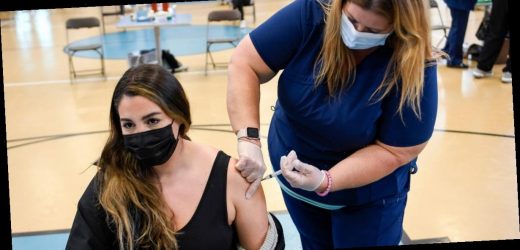- Three US vaccination sites temporarily stopped administering Johnson & Johnson’s shot this week.
- The sites reported clusters of adverse reactions, but it’s not known whether the shot was the direct cause.
- European regulators are also investigating rare blood clots tied to the vaccine, but experts aren’t worried.
- See more stories on Insider’s business page.
Johnson & Johnson’s coronavirus vaccine rollout hit several unfortunate snags this week — some far worse than others.
The New York Times reported on Tuesday that 62 million of the company’s vaccine doses must be checked for contamination, following an error at a Maryland manufacturing plant that already ruined 15 million doses. The plant’s workers accidentally mixed up some vaccine ingredients last month.
Then a vaccination site in Colorado, three sites in North Carolina, and one in Georgia all temporarily stopped administering Johnson & Johnson’s shot after about 45 people in total experienced minor adverse reactions involving nausea, dizziness, fainting, or lightheadedness.
To top it off, European regulators announced Friday that they are investigating Johnson & Johnson’s shot for links to unusual blood clotting after four blood-clot cases, including one death, were reported among vaccine recipients.
The timing of these developments was unfortunate, experts said, but there’s no reason to doubt the shot’s safety yet.
“You don’t want to be fueling unnecessary worries about the safety of vaccines when you’re still seeing an enormous outbreak and death rates all over the world from COVID,” Art Caplan, a bioethicist at New York University, told Insider.
He added that the side effects observed at the US vaccination sites were “absolutely trivial.”
Although symptoms like nausea and fainting aren’t common responses to coronavirus vaccines, they aren’t abnormal, either.
“When you see these clusters [of side effects], they usually are worked out and have no relation to the vaccine,” Arnold Monto, an epidemiologist at the University of Michigan’s School of Public Health, told Insider. Monto chairs the Food and Drug Administration’s Vaccine Advisory Committee, which voted to recommend the Pfizer, Moderna, and Johnson & Johnson shots.
People could get dizzy or nauseous for many reasons
Kristine Ko, right, waits in line for her vaccine at the Cal State LA walk-up mass vaccine site in Los Angeles on April 8.Al Seib/Los Angeles Times/Getty Images
Most of the negative reactions to Johnson & Johnson’s shot occurred within 15 minutes after a person got vaccinated, public-health officials in Colorado, Georgia, and North Carolina reported. In total between the three states, seven people were taken to hospitals for observation. As of Friday, all but one had been released and everyone was expected to fully recover.
Officials haven’t yet pinpointed why these clusters of adverse reactions were identified in such a short time frame. But they’ve emphasized that there’s no reason to be concerned about the shot itself.
In a news release, Georgia’s public health commissioner, Kathleen Toomey, said the state was looking into “what may have caused the reactions, including the conditions at the fairgrounds such as heat and the ability to keep the site cool.”
Caplan said it’s also possible that the people who felt dizzy or nauseous were elderly or had underlying health conditions that may have predisposed them to adverse reactions. And once one site reports a cluster of patient reactions, that makes others more likely to look for them and take swift action.
Whatever the reason, Monto said, the fact that adverse reactions are being reported and investigated shows that local officials are working hard to minimize harm.
“Any pause in vaccination shows that the system is working because we’re not trying to sweep anything under the rug,” he said.
In a statement, Johnson & Johnson told Insider that it takes all adverse reactions seriously. The company said it would “carefully assess the events” and share any findings with the FDA.
“There is no greater priority than the safety and well-being of the people we serve,” the statement said.
The link between J&J’s shot and blood clots remains tenuous
A vial of Johnson & Johnson’s shot.Michael Ciaglo/Getty Images
Just four blood-clot cases have been identified among people who’ve gotten Johnson & Johnson’s shot so far. In one of those cases, a participant in the company’s clinical trial died of a clotting disorder.
The other three blood-clot cases occurred during J&J’s US rollout, which has administered nearly 5.4 million doses of its vaccine. That’s fewer than one clot case per 1 million shots.
Experts aren’t convinced there’s a cause-and-effect relationship at all, though.
“It isn’t really clear how many people get blood clots anyway,” Caplan said. ‘That makes it hard to know whether it’s connected to vaccination.”
The European Union’s health regulator, the European Medicines Agency (EMA), announced its investigation after receiving information about the blood-clot cases from the FDA, Bloomberg reported. The EU authorized Johnson & Johnson’s vaccine in March and is scheduled to roll out the shot later this month.
The agency said it wasn’t sure what relationship, if any, existed between the vaccine and blood clots.
Earlier this week, the EMA announced that potentially fatal blood clots might be a rare side effect of AstraZeneca’s vaccine, which has been authorized in more than 110 countries but not yet in the US. Both that shot and Johnson & Johnson’s are viral-vector vaccines, which introduce a coronavirus gene into the body using a genetically engineered common-cold virus. Scientists don’t know whether the platform itself could be linked to clotting.
Still, any risk of clots should be weighed against the risk of getting COVID-19, Caplan said.
“If I live in Brazil and I’m still seeing 3,000 deaths a day, and somebody said to me, ‘We’re going to pull AstraZeneca vaccine out of here because we found somebody who died of a blood clot that might be related to the vaccine,’ I’d say, ‘You better recalculate your risk-benefit ratio,'” he said.
The bigger problem is a lack of supply
For now, the most pressing issue with Johnson & Johnson’s vaccine isn’t any safety concern — it’s the lack of consistent supply.
Johnson & Johnson promised to ship 24 million doses in US this month, but it’s unclear if the company will meet that goal, given the recent manufacturing issues, which occurred at a plant run by Emergent Biosolutions, a US government contractor.
Quality-control managers must first test 62 million doses to see if they can be salvaged, and the FDA must also certify that the Maryland plant can release more doses to the public.
Jeff Zients, the White House COVID-19 response coordinator, said at a Friday briefing that Johnson & Johnson “expects a relatively low level of weekly dose delivery” until the FDA signs off on the plant.
The total number of Johnson & Johnson shots allocated to states and other jurisdictions is expected to drop around 85% next week, to around 1.5 million doses. But that decrease follows an unprecedented surge of roughly 11 million doses last week.
Johnson & Johnson has said it’s still on track to provide close to 100 million doses by the end of May.
Allison DeAngelis contributed reporting.
Get the latest coronavirus business & economic impact analysis from Business Insider Intelligence on how COVID-19 is affecting industries.
Source: Read Full Article


